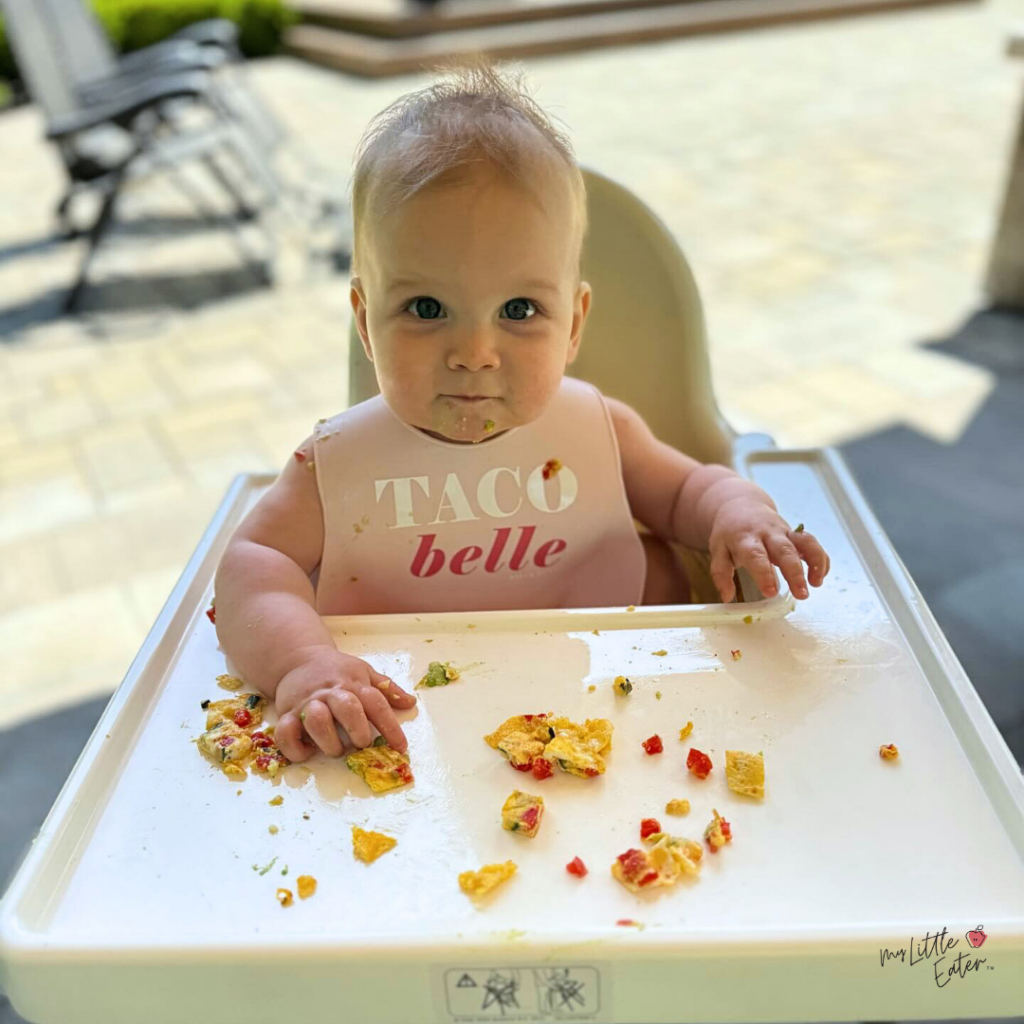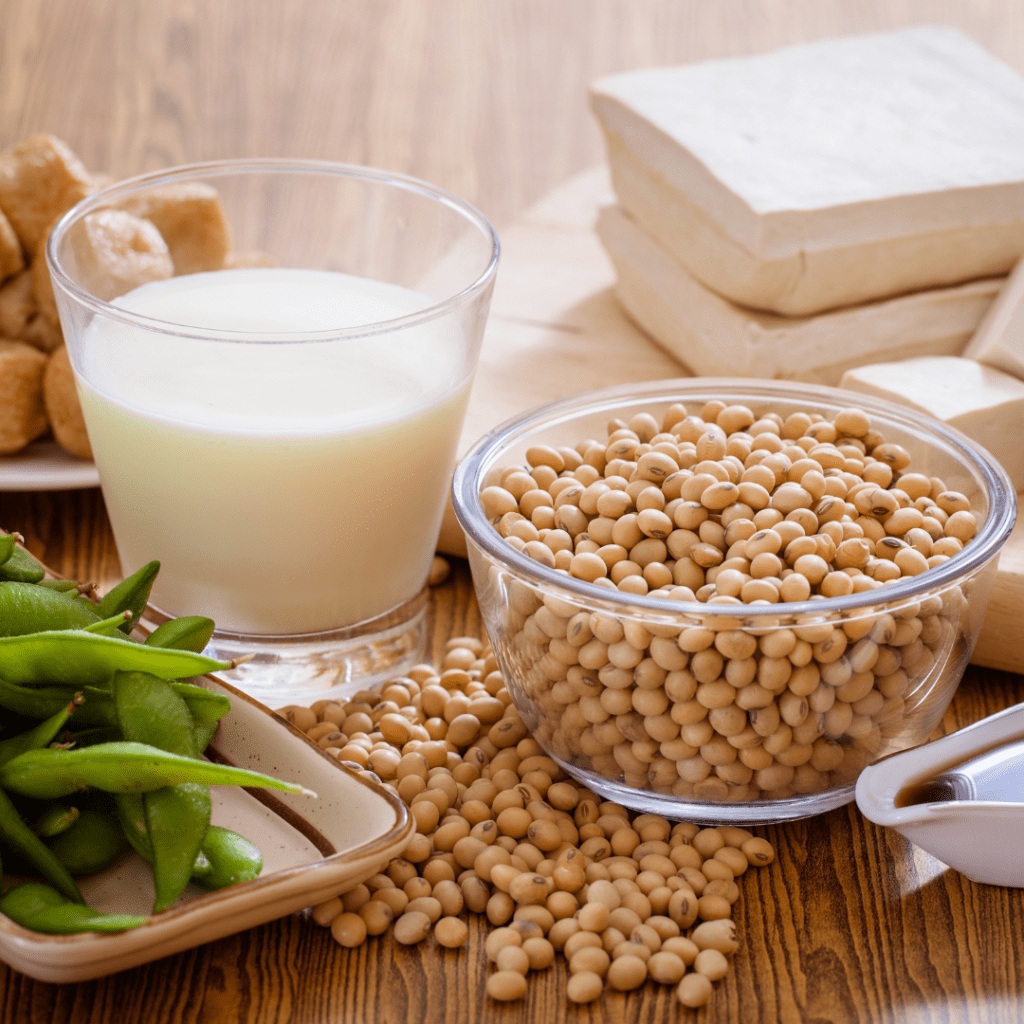*This post was sponsored by Tiny Sprouts Foods and contains affiliate links, please view our disclosure policy for more details.
Of all the foods to offer to babies and toddlers, nothing packs a punch like hemp, chia, and flax seeds. The tiniest of foods, these seeds (sometimes called super seeds), are a versatile way to add nutrition to just about any meal and offer reassurance to parents that their little ones are getting extra nourishment.
While other seeds can be offered to babies (like ground pumpkin seeds and sunflower seeds), this blog post will focus on the health benefits, meal ideas, and serving tips for chia, hemp, and flax seeds in particular.
All of these seeds can be served as early as 6 months of age, or when a baby shows the developmental readiness signs of starting solids. However, before you introduce seeds, it’s important to note portion sizes and how to safely serve them, as the properties of these seeds make it so that they may not be safe in large amounts for babies and toddlers.
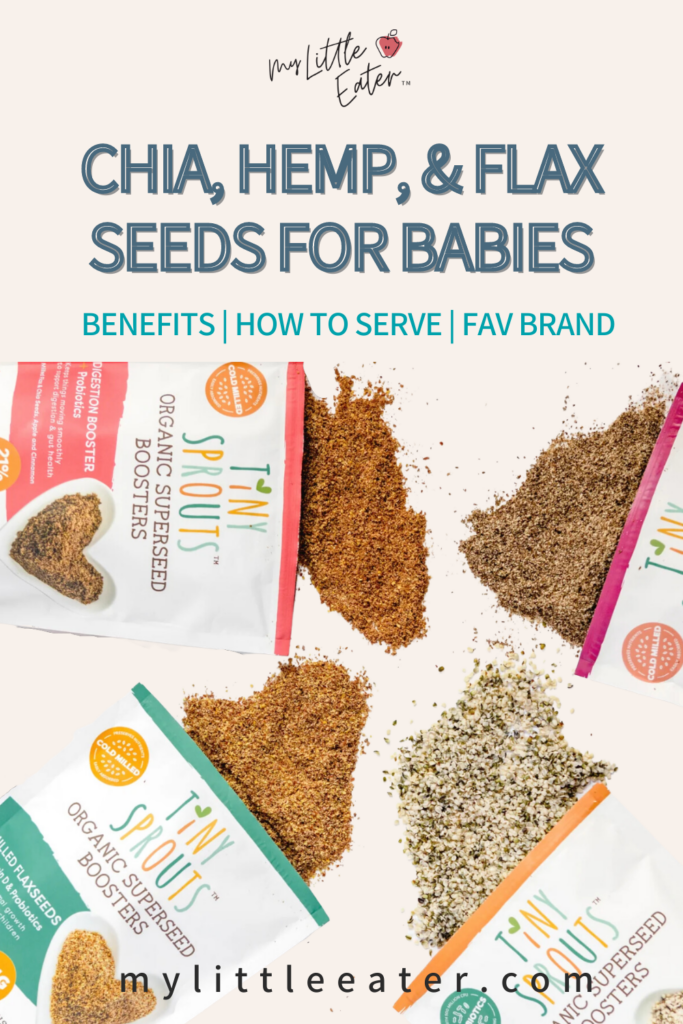
Table of Contents
For ultimate confidence in how to feed your baby from 6-12 months of age, join our Baby Led Feeding online course! This expert-led, video-based course teaches you all about starting solids with the feeding method that’s best for you and your baby. You’ll learn how to progress through a variety of textures in a timely way, prevent picky eating, serve all food safely, and raise a food-loving baby!
And now – it includes our Texture Timeline™ video library! Easily search for any food and find a video for exactly how to serve it according to age and phase! We’re continuously adding to this video library and we’ll soon have more than 100 food videos!
What’s the difference between flax, chia, and hemp seeds?

Flax seeds
Claim to fame: Omega 3s!
Flax seeds (also known as linseeds) are the most cost-effective seed option for moms that are looking for a nutritional boost (even though all super seeds are cost-effective). They also have the strongest flavor of the three super seeds, though it’s still a relatively mild, grassy taste.
- Flax seeds are known for their high amounts of alpha-linolenic acid (ALA), which is an omega-3 fatty acid that is important for heart health and converts to DHA to help support a child’s brain development. Note that the conversion rate to DHA is very low, so don’t rely on flax or other seeds alone to meet your child’s high DHA needs.
- Flax seeds are also high in antioxidants called lignans, as well as vitamins and minerals like B vitamins, iron, copper, zinc, and selenium.
- A somewhat controversial point to note about flax seeds is that unripe and raw flax seeds can have toxins that may be harmful if eaten in very high doses. That being said, it’s never been reported that any doses high enough to have any toxic effects have been consumed (1). So – no need to stress or avoid it altogether! To be safe – we recommend offering no more than 1 tbsp of flax seeds a day to babies under 12 months, and no more than 2 tbsp from 1-3 years+.
- Flax seeds are also high in fiber and are a great way to naturally treat constipation.
Note: Flaxseed oil is more absorbable in ALA’s than flax seeds themselves. However, the fiber and lignans are removed, meaning it won’t have the same effect on constipation and the digestive system.
Chia seeds
Claim to fame: Fiber!
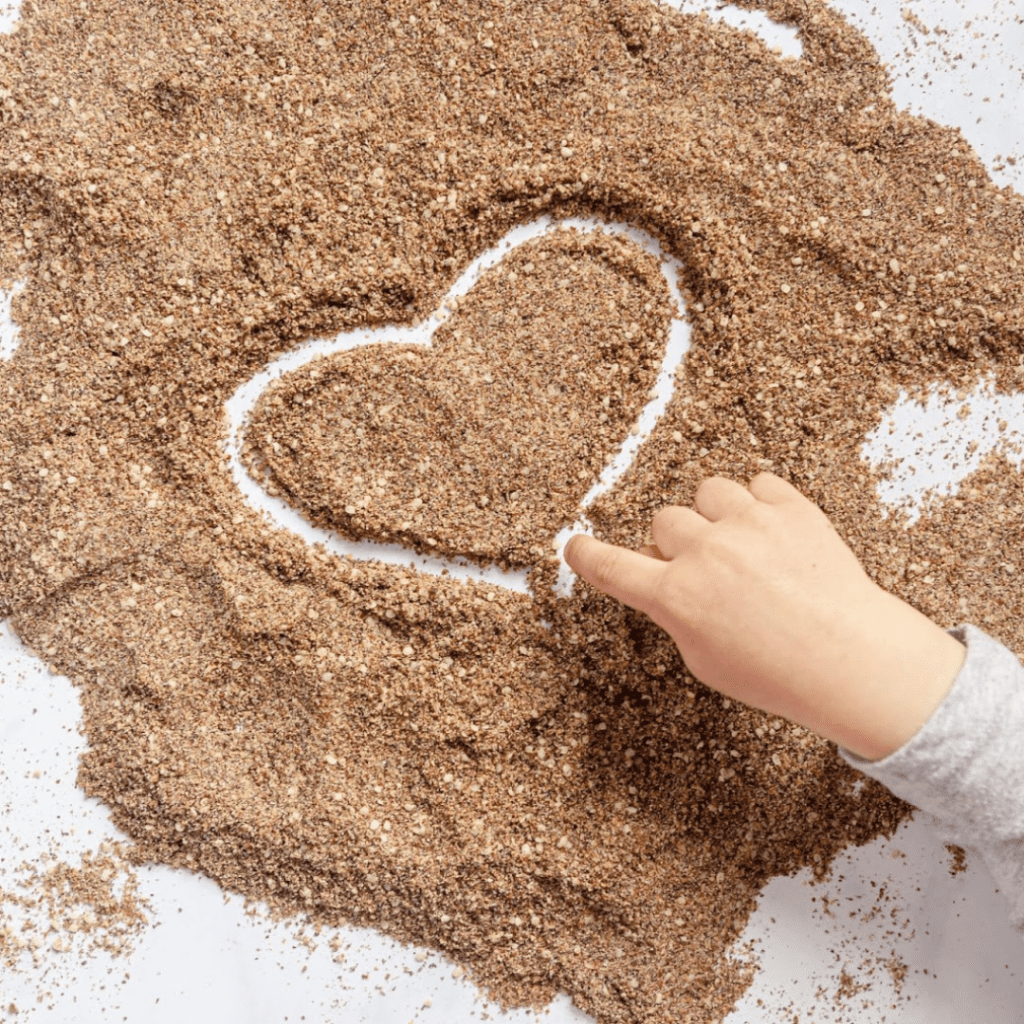
Chia seeds are darker in color and have even more fiber per gram than flax seeds (which is saying a lot!). They are virtually tasteless seeds, but they do slightly change the texture of foods and make them more gel-like once all that soluble fiber is mixed with a liquid.
- The type of fiber primarily found in chia seeds is soluble fiber, which is great for keeping bowel movements soft and moving along (aka for constipation!). They also contain a good amount of omega-3 fatty acids, as well as key elements like calcium, phosphorus, manganese, and zinc (2).
- Gram for gram, chia seeds have more calcium than milk! Don’t let that fool you though – because a toddler can drink a whole glass of milk (and get more calcium that way), while chia seeds should be limited to smaller amounts due to their extremely high fiber content and the potential to fill babies up too much, as well as cause digestive upset.
Hemp seeds
Claim to fame: Protein!

Hemp seeds have a slightly nutty taste and don’t have any restrictions in terms of how much can be served in a day – so sprinkle away! You may hear the term “hemp hearts” being used, which refers to hulled hemp seeds (meaning, the outer shell has been removed). This makes it easier to digest and serve to babies and toddlers.
- Hemp seeds are known for providing ample amounts of protein per serving – where 3 tbsp provides around 9.6 g of protein (and over 50% of a toddler’s protein needs for the day)! To top it off – it’s a complete protein – meaning it has all the essential amino acids required for proper health. It has a perfect ratio of omega-3 to omega-6 fatty acids, and is high in gamma-linolenic acid (GLA), which is a hormone that acts as an anti-inflammatory (3).
- Hemp seeds also contain high amounts of phosphorous, magnesium, and potassium. In fact, 1 tbsp of hemp seeds provides over 70% of a child’s magnesium needs – nature’s tranquilizer – and helps your little toddler go right to bed.
Do hemp, chia, and flax seeds have to be ground before eating them?
While hemp seeds don’t need to be ground before eating, as they’re already highly digestible, we always recommend consuming chia and flax in their ground (hulled) form.
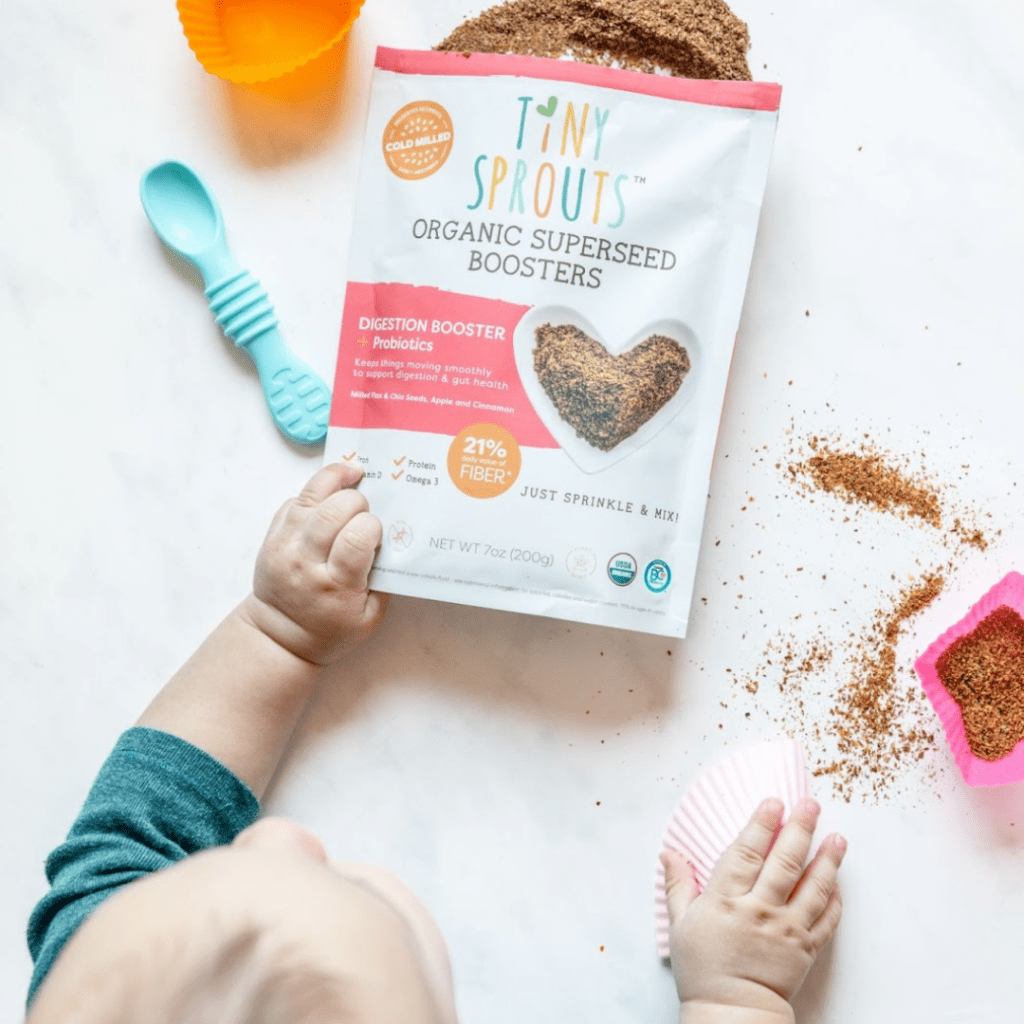
Ground (or milled) seeds refer to whole seeds that have been finely ground into a powder form, removing the tough outer shell that makes it harder to digest. Flaxseed, for example, will pass right through your body without being digested if consumed whole, meaning you (and your baby) will miss out on most of the nutritional benefits of the seed.
When it comes to chia seeds, although they’re easier to digest and will still have nutritional benefits from consuming them whole, you can get more absorption of omega-3s, antioxidants, and protein when they’re eaten in ground form (4, 5).
Chia seeds are a lot less common to find in ground form, so you have the option of grinding them at home in a coffee grinder, blender, or food processor. You can also take a look at our favorite seed company Tiny Sprouts, which has a beautiful cold-milled formulation perfect for ages 6 months+.
Once ground, flax and chia seeds are more prone to oxidation and spoilage so should be packaged in a light-protective pouch and refrigerated in an air-tight container after opening (see the section on storage below).
How to store hemp, chia, and flax seeds

Because of the high levels of omega-3’s and healthy fats, hemp, chia, and flax seeds should all be refrigerated or stored in a freezer and in a dark container to maintain them in a cool, dark environment.
Omega-3’s in particular are a really delicate oil, and if it’s exposed to light, heat, or humidity, it starts to deteriorate quickly and can go rancid.
That’s why it’s important when shopping for these seeds to look for ones that aren’t stored in a packaging with a window to “see” the product, as it lets light in and compromises the integrity of the seeds.
If you’re buying the seeds in bulk and storing them in your own storage container, ensure it’s a dark container that’s sealed tight so that no oxygen can enter, and place it in the back of the freezer to ensure it’s dark.
Our favorite baby and toddler super seed brand - Tiny Sprouts
Tiny Sprouts Foods produces easy, convenient, and nutrient-rich super seed blends with chia, flax, and hemp that are specially formulated for kids! They’re cold-milled & hulled (outer shell removed) for easy digestion and maximum nutrient absorption in little bodies. They also fortify their blends with vegan vitamin D & probiotics, which are so critical for the development of babies and toddlers, and why we recommend Tiny Sprouts on the daily! They also test their boosters for heavy metals to ensure the utmost purity of their products – which we love.
You can get 10% off your Tiny Sprouts order using code MYLITTLEEATER at checkout.
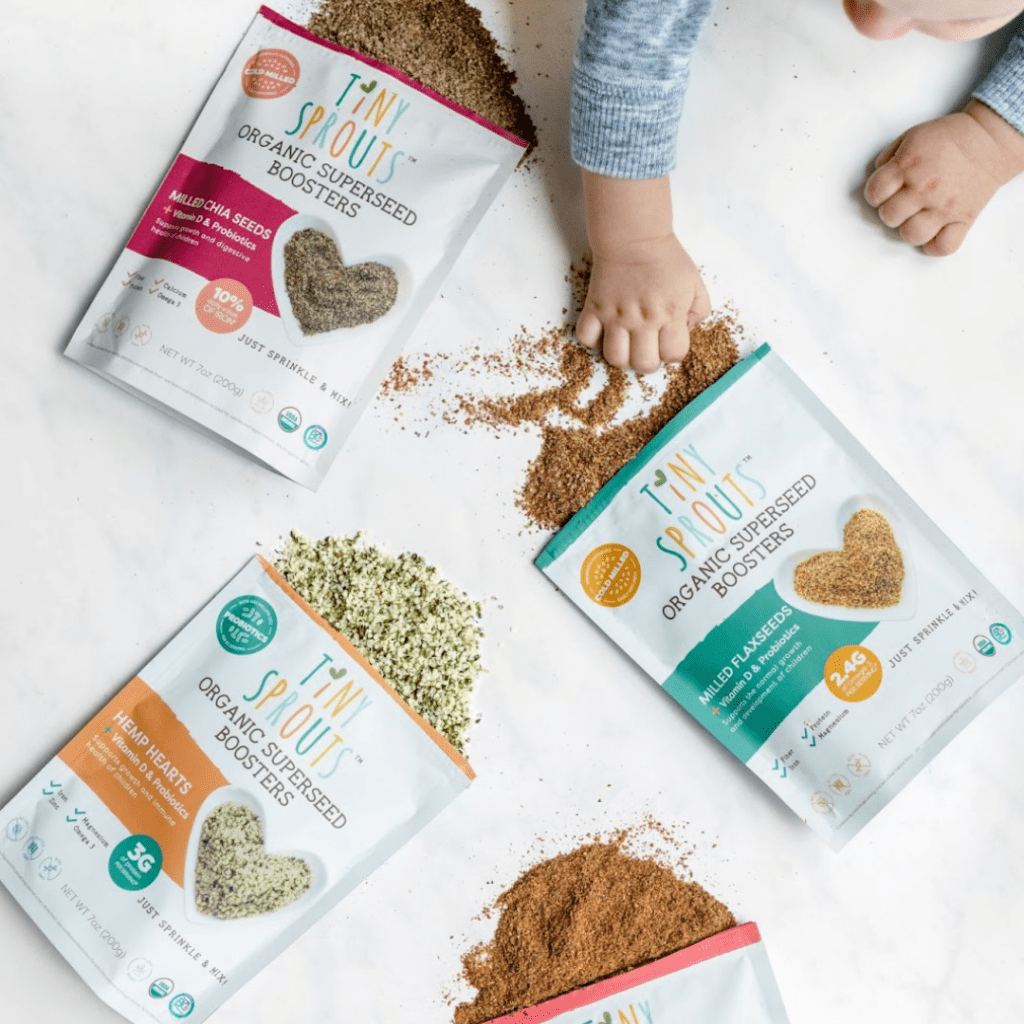
You can also learn more about Tiny Sprouts, the many benefits of these super seeds, and how to include them in your child’s diet, by listening to our podcast interview with the founders below.
Are hemp, chia, and flax seeds choking hazards?
Between hemp, chia, and flax seeds, whole chia seeds pose the highest choking risk.
Because they expand when they come in contact with water or other liquids, a very minor risk of eating whole chia seeds is that they could potentially expand in the esophagus if it’s quickly followed by some water or other liquid food. As a precaution for babies and toddlers especially, it’s advisable to let chia seeds sit in a liquid or moist food like yogurt or oatmeal for a short period of time – just enough to let them fully expand – and then offer it to your child.

Hemp seeds and flax seeds are not considered high-choking risk foods at all, although technically any food can be choked on. Be sure to feed your baby in a safe eating environment and be familiar with gagging and choking protocols.
What’s an appropriate portion size for hemp, chia, and flax for my baby?
Because all these seeds contain high amounts of fiber, we recommend not adding too much to your baby’s diet or toddler’s diet right away.
Start with ½ tsp mixed into a meal and watch for any digestive symptoms like diarrhea or gas. You can gradually add more from there, bit by bit.
For the total recommended amounts to be consumed in a day, try to stick to within the following guidelines:
Recommended serving sizes for milled flaxseeds and chia seeds (up to 2x/day):
- 1 tbsp serving (5g) for babies ages 6-12 months
- 2 tbsp serving (10g) for children ages 1-3 years
- 3 tbsp serving (15g) for kids 4+ years.
Recommended serving sizes for hemp hearts (up to 2x/day):
- 2 tsp serving (5g) for babies ages 6-12 months
- 1 tbsp serving (8g) for children ages 1-3 years
- 2 tbsp serving (16g) for kids 4+ years
It’s also important to give your child a bit of extra hydration via water, breast milk, or formula when introducing high-fibre foods into the diet to help with digestion and keep stools moving through the body.
How do I safely serve flax, chia, and hemp seeds to my baby?
Hemp, flax, and chia seeds can be easily sprinkled on top of any food, mixed into batters, sauces, and spreads, and even made into various recipes that are easy and healthy!
Our favorite tip for toddlers is to put any one of these seeds in an emptied-out salt shaker or spice container, and have them add “sprinkles” to their food before a meal! It’s so fun for them to do on their own and it’s a great way to get them involved in their own nutrition.
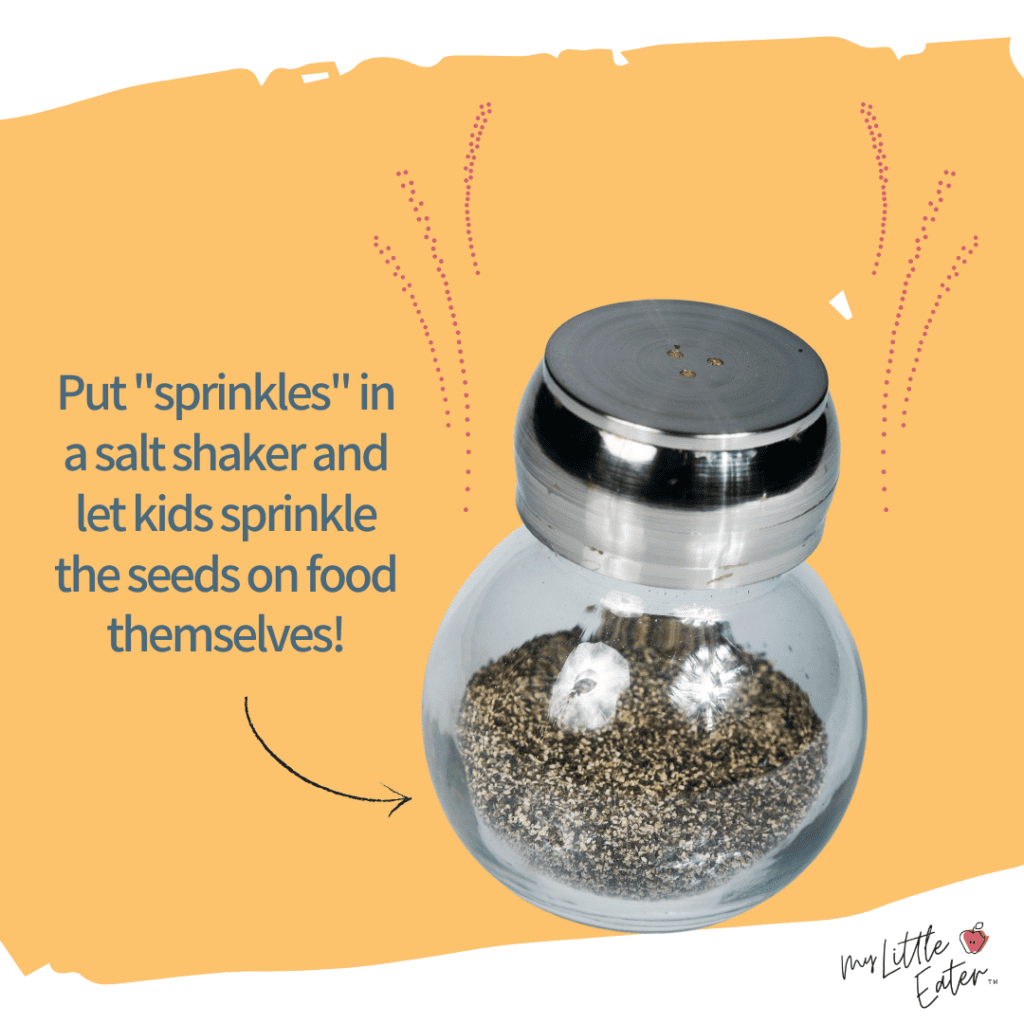
Here are some of our favorite ideas for foods you can sprinkle any of the seeds on:
- Yogurt
- Oatmeal
- Dips like guacamole or salsa
- Toast with a spread (like peanut butter)
- Cottage cheese
- Soup
Because chia forms more of a gelatinous mixture upon contact with moisture, it’s best used in puddings, smoothies, and jams.
Here are some ideas that we love so that you can add chia seeds to the menu:
- Use them to thicken up a smoothie
- Chia seed jam
- Chia pudding
- Chia egg (egg substitute in recipes)
- Add them to a salad dressing
Flax and hemp seeds are a little more versatile and can virtually blend into almost any food with little effect on flavor (and, depending on how much is present, texture).
Flax and hemp seed use:
- Mixed into meat mixtures like meatballs or meatloaf
- Mixed into a pasta sauce
- Mixed into muffin or bread batters
- Use to coat slippery foods for baby led weaning, like avocado or banana
- Mixed into pancake or waffle batter
- Flax egg (egg substitute in recipes)
Was this helpful? Pin it to save for later!
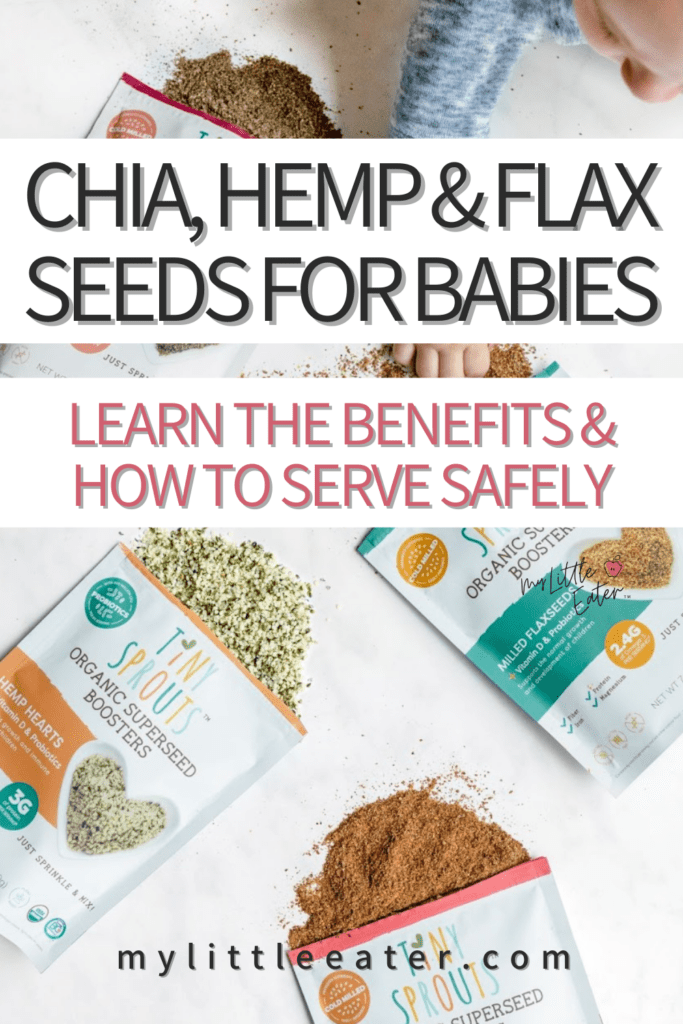
References:
- https://www.ncbi.nlm.nih.gov/pmc/articles/PMC6567199/#:~:text=Toxicity%20of%20Flaxseed,identified%20as%20potential%20toxic%20compounds.
- https://www.hsph.harvard.edu/nutritionsource/food-features/chia-seeds/
- https://lupinepublishers.com/research-and-reviews-journal/fulltext/nutritional-properties-and-health-effects-of-hemp-seeds.ID.000258.php
- https://pubmed.ncbi.nlm.nih.gov/22830971/
- https://pubmed.ncbi.nlm.nih.gov/32150813/

about the author
EDWENA KENNEDY, RD
Founder and lead Registered Pediatric Dietitian at My Little Eater Inc., creator of The Texture Timeline™, and mom of two picky-turned-adventurous eaters.
